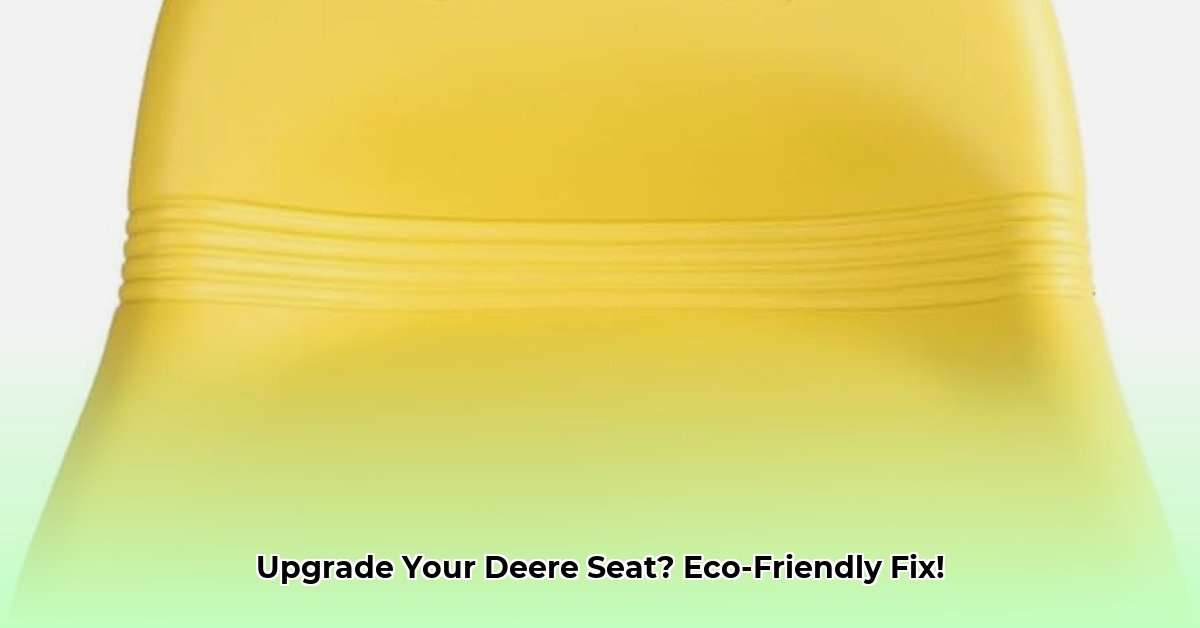
A worn-out tractor seat cushion isn't just uncomfortable; it impacts your workday efficiency and can even contribute to long-term health problems. Replacing it is a simple yet significant step towards maintaining both your well-being and the sustainability of your farming operation. For other tractor brands, see helpful guides like this one on Ford tractor seat replacement. This guide provides a step-by-step approach to replacing your John Deere tractor seat cushion, emphasizing eco-friendly choices for a healthier planet and a more comfortable you.
What You'll Need
Before starting, gather these essentials:
- Screwdrivers (Phillips and flathead) (To remove and install seat components)
- Wrenches (Sizes vary by tractor model; check your owner's manual) (Used to loosen and tighten fasteners)
- New seat cushion (Choose a sustainable option whenever possible) (Replaces the worn-out cushion)
- Clean rags or towels (For cleaning and wiping) (Helps maintain a clean work area)
- Replacement seat mounting hardware (Optional, but recommended) (Ensures secure reassembly)
- John Deere tractor owner's manual (Essential for model-specific instructions) (Provides guidance for your specific tractor model)
Step-by-Step Replacement Guide
Safety First: Always disconnect the tractor's battery before beginning any repairs. This prevents accidental electrical shocks and ensures your safety.
Seat Removal: Consult your owner's manual for precise instructions on removing your tractor's seat. Typically, this involves removing bolts or other fasteners securing the seat to the tractor frame. Take photos as you disassemble to aid reassembly.
Old Cushion Removal: Carefully detach the old cushion from the seat. This may involve unfastening straps, zippers, or other attachments. Again, photograph the process for later reference. Note the position of any electrical connectors linked to the seat heating, etc., taking photos for accurate reassembly.
New Cushion Installation: Position the new cushion in the seat, ensuring proper alignment. Secure any straps, zippers, or other fasteners. Make sure any electrical connectors are correctly reattached.
Seat Reinstallation: Reattach the seat to the tractor frame following the steps and photos you took during removal. Double-check that all fasteners are secure.
Battery Reconnection: After ensuring the seat is securely mounted and all components are correctly reconnected, reconnect the tractor's battery.
Testing: Sit in the seat and test its functionality. Assess comfort and adjustability. Take a short test drive to confirm everything is working correctly and there are no rattles or loose components.
Troubleshooting Common Issues
Stubborn Fasteners: If fasteners are difficult to remove, use the correct tool and apply penetrating oil (like WD-40). Avoid excessive force to prevent damage.
Misaligned Cushion: If the cushion isn't aligned, remove and reposition it before securing it again.
Missing Parts: If parts are missing, consult your owner's manual or contact your local John Deere dealer for replacements.
Choosing Sustainable Cushions: An Eco-Friendly Approach
Selecting a sustainable cushion minimizes your environmental impact. Look for cushions made from recycled materials or those with a smaller overall environmental footprint. While these options might cost slightly more initially, their durability often leads to longer lifespan, reducing waste over time. Consider certifications such as GOTS (Global Organic Textile Standard) for organic materials, indicating environmentally friendly manufacturing practices.
Several online retailers and John Deere dealers offer a range of replacement cushions, both OEM and aftermarket. The best choice depends on budget and the availability of sustainable options.
The Broader Impact: Sustainability on Your Farm
Regular tractor maintenance, including seat cushion replacement, contributes significantly to farm sustainability. A comfortable operator is a productive operator, leading to increased efficiency and reduced waste. This translates to lower fuel consumption, decreased emissions, and improved overall environmental performance. Investing in durable, sustainable components reduces the disposal of worn-out parts, further lessening the environmental footprint of your farming operation.
Cost-Benefit Analysis: A Small Investment, Big Returns
The cost of a new seat cushion is minimal compared to the potential costs – discomfort-related reduced productivity, health issues, and even premature tractor replacement. Prioritizing operator comfort through regular maintenance ensures efficient use of your equipment and extends the lifespan of your tractor.
Long-Term Sustainability Strategies
- Regular Maintenance Schedule: Implement a routine maintenance plan to prevent larger, costlier repairs.
- Sustainable Material Prioritization: Always prioritize durable, environmentally friendly replacement parts.
- Research Eco-Friendly Options: Explore recycled or bio-based materials for your equipment.
- Support Sustainable Manufacturers: Choose suppliers committed to sustainable practices.
By actively choosing and implementing these sustainable practices, you contribute to environmental responsibility while optimizing farm productivity and enhancing your comfort and working conditions. Replacing your John Deere tractor seat cushion is a simple act with substantial long-term benefits.